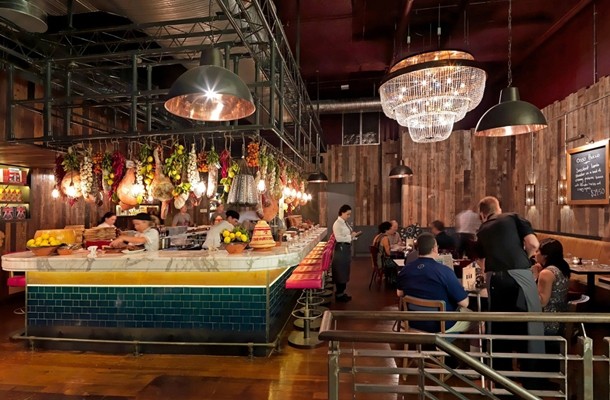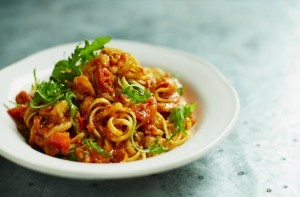Business Profile: Jamie's Italian

Running a restaurant spearheaded by a celebrity chef is something of a double-edged sword. Indeed, Simon Blagden, chief executive of the Jamie Oliver Restaurant Group, admits that those are the words used internally to describe the pros and cons that come with being so closely associated with one of the world’s best known foodie figures.
“Jamie’s profile attracts interest. If you go to a new territory overseas you get a lot of attention, as we did here when we started,” says Blagden. “People driving three hours to one of our first sites, to then queue for three hours, is not a sustainable model. The positives outweigh the negatives, but everything we do has to be squeaky clean. The due diligence around our brand is significant; we can’t cut corners. The phrase we use to our managers and staff is treat everyone like a critic.”
Earlier this year, Oliver appointed the Royal Bank of Canada to explore options regarding his restaurant group, including a sale of a stake in the business, which is valued at around £200m. It is thought that the group explored a number of options for future growth, including securing a new investment partner (it is currently self-funded). It is understood to have received a significant amount of interest but that no suitable custodian could be found who matched the values set down by Oliver.
As a result, the business will continue with a self-funding model, through a mix of cash flow and royalty income from its numerous overseas franchise deals. It is thought that funds brought in from any sale would have been used in part to finance the continued expansion of both Jamie’s Italian and the chef’s top-end steakhouse format, Barbecoa.
“We genuinely wanted to see who was out there in regards to funding and what the options were,” says Blagden. “We could have done a deal with a couple of investors but actually felt we were better off for now as a private business making our own decisions and maintaining our own values.”
Performance issues
Some have questioned whether a drop in performance in the UK has also had an impact on the level of interest for the business. Although there has been some inevitable decline during the past few years while the rest of the sector has played catch-up, Blagden is happy with where the group is.
“This year we are very pleased with how things are going. The UK for us has really steadied and we are starting to see some improvements across the estate from spring through the summer. We have also launched a number of initiatives to improve our profitability,” he says.
Jamie’s Italian’s 20-strong overseas businesses are going well too. “Some are blockbusters, most are very good and then there are pockets where we have issues, like Russia where the Moscow market is not doing so well at present,” says Blagden. “But we are confident that, with our partners who own around 100 restaurants out there, we are in the best place to deal with it and open more sites at the right pace.
Other territories, including Australia, where we have six sites now, are very strong. The two in Singapore and Hong Kong are also doing well. Our Sao Paulo restaurant is doing around 1,000 covers a day. Generally we are really pleased, as are our partners.”
Back in the UK, Blagden characterises the market as highly competitive but believes his brand is still as strong as when the first Jamie’s opened its doors back in 2008.
“Generally, I think the sector has done nothing but improve over the past six to seven years through some difficult times,” he says. “The competition is a lot better than a few years ago, which makes it harder to stand out from the crowd. There are elements of our business that have been replicated in other formats – say the industrial look we had – but the core of our business can’t be replicated. Our USPs are around food quality, provenance, a good kids offering, quality service and the atmosphere of the restaurants.
“From the market research we look at, I believe we are still up there among the top performers. We haven’t discounted or used vouchers, which means we are perceived as a bit more premium.”
UK Vs. The World
Blagden admits there is a limit to how many restaurants the group will open in the UK (it currently operates 45). He also hints that the company may not do many more openings under its fledgling Trattoria format, which is basically a smaller version of the group’s core offer. It currently operates three sites under the brand in Richmond, south-west London; Tunbridge Wells, Kent; and Chelmsford, Essex.
“The question for us is how many Jamie Oliver restaurants should there be in the UK? Not so much will happen in the UK for Jamie’s Italian going forward. We have done all the major cities and decent suburbs and shopping malls. There will be one UK opening next year. We have to be careful people don’t get fed up of Jamie. Maybe 50 is the right number, with Trattoria included; that might be a nice size of business. If you then have international growth on top, that could be a nice model going forward for us.”
UK expansion will become much more strategic but the group will continue to build its international presence with 12 to 14 new openings planned for the next 12 months or so.
Blagden says the key challenge overseas is finding partners that care about the business as much as the company does.
“We are only at the start of the process internationally, with just 20 restaurants. The aspiration is to have huge numbers. It’s about bedding in those values and getting people aligned with that so we can grow together,” he says.
The group further strengthened its global presence with new openings in Indonesia, Hong Kong, Australia and Singapore over the summer. At the same time, the company signed a deal with Italian company Food Concepts to ramp up its presence in Europe, setting its sights on Belgium, Holland and Germany.
The first site under the franchise deal will open in the Markthal in Rotterdam this autumn. It has further openings lined up in Hungary, South Africa, Cyprus, New Zealand and Canada.
The power of the brand abroad is summed up by the group’s first opening in Brazil, in Sao Paulo, which has quickly become one of the brand’s best performing sites. But perhaps the most lucrative market
for Jamie’s Italian will be in the US where the chef has enjoyed particularly high exposure.
“It won’t be long before we see Jamie’s in the US. I hope next year, that is the plan. We want it to be company owned. There is definitely risk involved going there but we have a head start with the Jamie’s brand and also in areas such as health, nutrition and provenance,” says Blagden.
Capital expenditure
While the expansion of Jamie’s Italian is slowing, the group still has some major projects coming in London, not least an opening at the Fish and Coal buildings in King’s Cross, which will be a pub, restaurant and a substantial social hub for staff training and development, plus an academy.
There is also more growth planned for Barbecoa, with a launch in the Far East planned for next spring. The company has signed a deal with The Blind Group, which is led by ex-Jamie Oliver Restaurant Group operations director Jacques Dejardin, to open in Singapore next year. It is thought the group is also exploring an opening for the format in Bangkok.
In London, the group is set to unveil its second Barbecoa at the end of this year at 194-196 Piccadilly. It is thought a third will launch in the Nova development in Victoria. The first Barbecoa opened in New Change Passage near St Paul’s in the City in 2010.
While most things Oliver and Blagden have touched have worked, Oliver’s profile made sure the one that didn’t – ‘British flatbreads’ concept Union Jacks – got plenty of attention.
Blagden admits its failure set the group back a bit.
“We got a head of steam with Jamie’s Italian, which then gave us the confidence to try other things. I think we tried to be too clever. The original idea of a pizzeria got taken off course by the British food book Jamie was doing at the time plus other bits around the edges.
“Also, there was a phase we went through, going back four or five years, when we thought we could walk on water. Actually, it was a really good lesson. It helped that we pulled it quickly and moved on.”
Coping with demands
Talking to Bladgen you get the sense that he and his team have dealt with everything and anything that could have been thrown at them in regards to working for the country’s most high-profile chef and his campaigns, the most recent of which is adding a 10p levy on sugary soft drinks.
“We have had no push-back on the decision to introduce a levy on our soft drinks, people have been, in the majority, supportive. On the whole it has been positive. We’ve got quite a bit of support from other operators already and a national business is set to join the campaign soon,” he says.
But is Oliver as hands-on as he was at the beginning?
“Of course. For example, he looks at all the social media feedback so I get random texts at three in the morning and then again at six! He is also involved in the food development and the design of the restaurants.”
So here we have a restaurant group that remains in a strong proposition, is profitable, trading very well, has a strong core UK base and significant potential to expand overseas. But also one with a namesake who is rarely out of the UK press and is unafraid to ruffle feathers. For now Blagden remains at the sharp edge of a double-edged sword.































